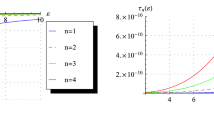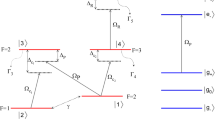Abstract.
Effects of confinement on the electron-electron (e-e) and electron-phonon (e-ph) thermalization dynamics in noble metal clusters are calculated using simple approaches. The model predictions are compared with femtosecond pump-probe measurements which display an acceleration of the e-e and e-ph relaxation dynamics. The size-effects on the e-e relaxation dynamics are consistent with a model involving the surface-induced reduction of the screening efficiency of the Coulomb e-e interaction. With regard to the e-ph relaxation dynamics, this model yields too large time constants, pointing out deficiencies of the standard modelling of the e-ph energy exchanges in bulk metals. Analysis of these deficiencies shows that the bare e-ion interaction has to be involved in the transition matrix element describing the non-adiabatic e-ph energy exchanges.
Similar content being viewed by others
References
C. Voisin, N. Del Fatti, D. Christofilos, F. Vallée, J. Phys. Chem. B 105, 2264 (2001)
S. Link, M.A. El-Sayed, J. Phys. Chem. B 103, 8410 (1999)
J.Y. Bigot, V. Halté, J.C. Merle, A. Daunois, Chem. Phys. 251, 181 (2000)
C. Voisin, D. Christofilos, N. Del Fatti, F. Vallée, B. Prével, E. Cottancin, J. Lermé, M. Pellarin, M. Broyer, Phys. Rev. Lett. 85, 2200 (2000)
J.H. Hodak, A. Henglein, G.V. Hartland, J. Chem. Phys. 112, 5942 (2000)
M. Nisoli, S. Stagira, S. De Silvestri, A. Stella, P. Tognini, P. Cheyssac, R. Kofman, Phys. Rev. Lett. 78, 3575 (1997)
A. Arbouet, C. Voisin, D. Christofilos, P. Langot, N. Del Fatti, F. Vallée, J. Lermé, G. Celep, E. Cottancin, M. Gaudry, M. Pellarin, M. Broyer, M. Maillard, M.P. Piléni, M. Treguer, Phys. Rev. Lett. 90, 177401 (2003)
J. Lermé, B. Palpant, B. Prével, M. Pellarin, M. Treilleux, J.L. Vialle, A. Perez, M. Broyer, Phys. Rev. Lett. 80, 5105 (1998)
D. Pines, P. Nozières, The Theory of Quantum Liquids (Benjamin, New York, 1996)
J. Bardeen, Phys. Rev. 52, 688 (1937)
Let us emphasize that in the e-e dynamics modelling, the same screening weighting factor epsilon(q)-1 is associated to the corresponding Fourier component of the bare Coulomb e-e interaction (\(\textbf{q}\) is the electronic wave-vector exchanged during the e-e scattering event). However, in this case, the global e-e scattering rate is the net result of a non-trivial multi-integral over allowed momentum and energy values of both partners in the initial and final states, yielding a considerable lowering of the epsilonb-dependence. In this respect, one has to mention that the τe-e time constants for the films corroborate the expected square-root dependence predicted by the Fermi liquid theory
C. Kittel, Introduction to Solid State Physics (Wiley, New York, 1983)
O. Madelung, Introduction to Solid-State Theory, edited by M. Cardona, P. Fulde, H.J. Queisser (Solid-State Sciences, Springer, Berlin, 1996)
J. Bardeen, D. Pines, Phys. Rev. 99, 1140 (1955)
R. van Leeuwen, Phys. Rev. B 69, 115110 (2004)
S. Baroni, S. de Gironcoli, A. Dal Corso, P. Giannozzi, Rev. Mod. Phys. 73, 515 (2001)
Developed in terms of one-electron Bloch-states (defined in the equilibrium lattice configuration) and phonon states, the BO global state can be shown to look like the perturbative expansion giving the scattering state vectors of the quantum theory of scattering in the time-independent approach. Analysis of this expansion shows that the screened e-ion interaction is actually involved in this case
In a forthcoming paper we will show that the normalized phonon frequencies \(\omega(\textbf{q})\) obtained in the BO approach can be expressed in terms of the \(\textbf{q}\)-Fourier components of the two-body e-ion and ion-ion interactions and \(\epsilon(\textbf{q})\), exhibiting — for pure Coulomb interactions — the correct long-wavelength behaviour \(\omega(\textbf{q})=\Omega/\epsilon(\textbf{q})^{1/2}\), where Ω is the bare ionic plasma frequency. All the aspects of the screening effects, in relation with the e-ph coupling problem, investigated through the BO approach, will be reported and discussed in a detailed forthcoming paper
E.D. Belotskii, P.M. Tomchuk, Int. J. Electron. 73, 955 (1992)
Author information
Authors and Affiliations
Corresponding author
Rights and permissions
About this article
Cite this article
Lermé, J., Celep, G., Broyer, M. et al. Effects of confinement on the electron and lattice dynamics in metal nanoparticles. Eur. Phys. J. D 34, 199–204 (2005). https://doi.org/10.1140/epjd/e2005-00107-8
Received:
Published:
Issue Date:
DOI: https://doi.org/10.1140/epjd/e2005-00107-8




